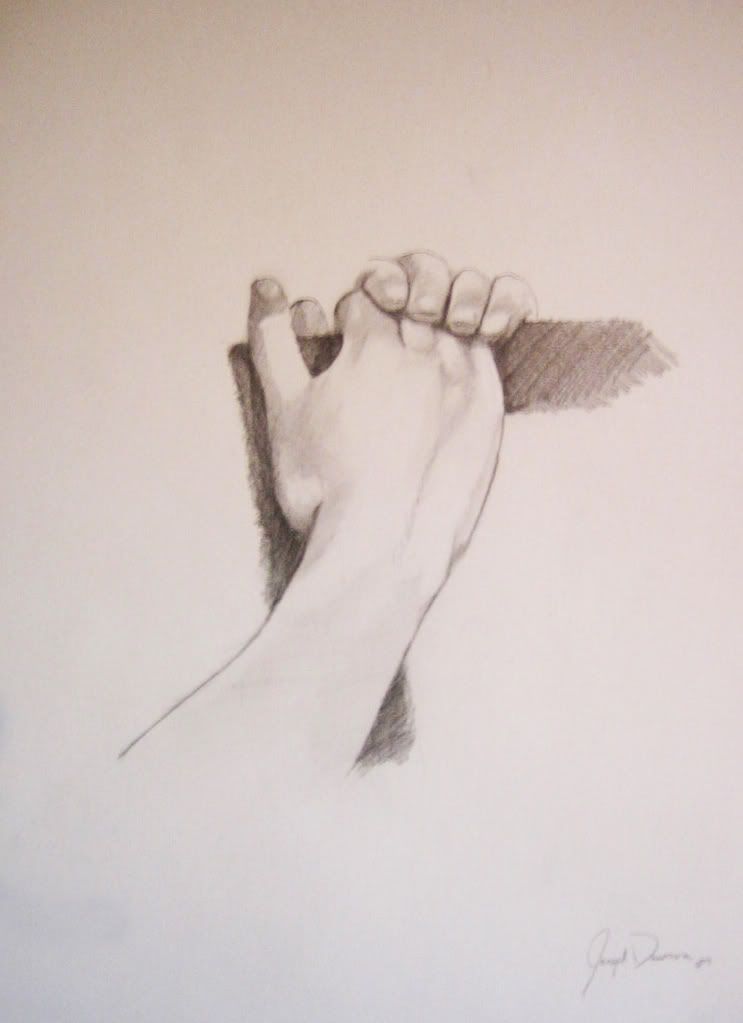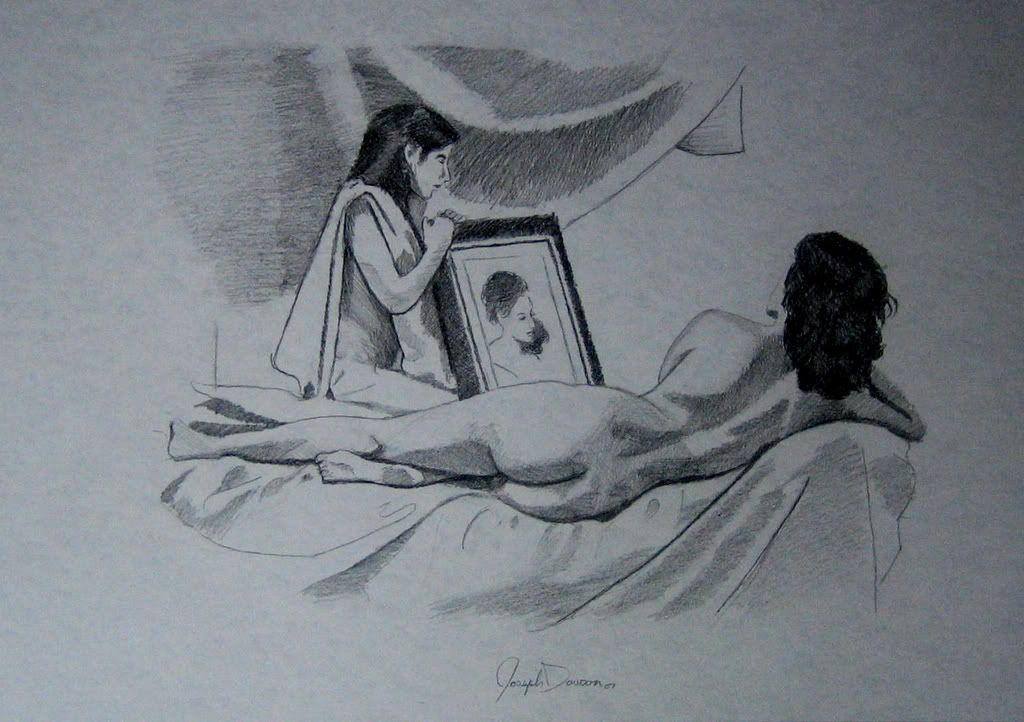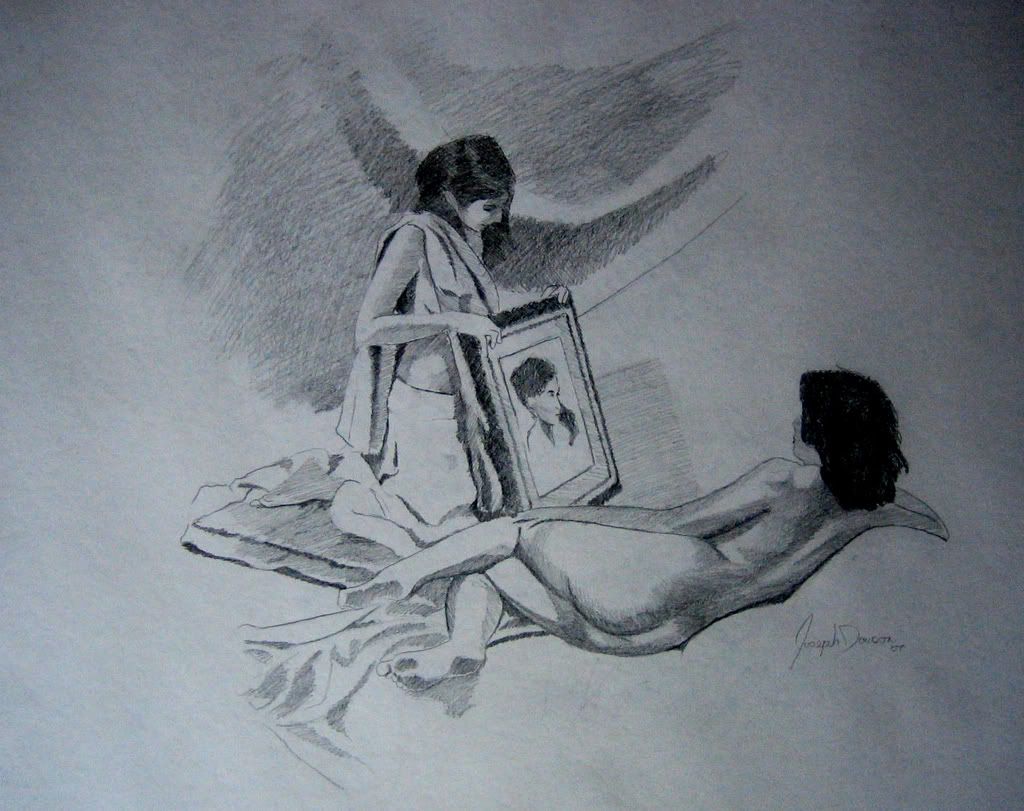Saturday, November 17, 2007
On The Portrait
An interesting thing to note regarding the Rokeby Venus is that the image portrayed in the mirror is not faithful to the laws of optics. Given the position of the mirror, Venus should not have been able to see herself. In her place, one should see the observer or the painter standing behind her. It is also interesting to note that the face in the mirror is not reduced in size. Mind you, having a 1:1 ratio is possible if the mirror being used happens to be concave and not the standard flat face mirror. By including a mirror, one can only conjecture that Velazquez wanted to form a complete idea of the woman’s beauty and by taking liberties with the optics, he was able to do so.
For my part I wanted a faithful portrait of the woman as well, yet I did not wish to make the same concessions that Velasquez had. To this end I have decided to abandon the mirror concept altogether and in its place have the lady in attendance holding a painting of my Venus. Now, this presents two very interesting challenges.
Firstly, it is usually the artists endeavour to try and create the illusion of a three dimensional quality on a two dimensional surface and so we work with tone, light, values and colours in order to achieve our effects. It is an entirely different thing to paint a painting in a painting and have it look like a three dimensional form locked onto a two dimensional surface. In a sense I am trying to make the internal portrait less real than the reality of the Venus contemplating it.
The next and perhaps most daunting task is to make the image conform to a second perspective. Not only do I have to do a portrait, but a portrait (with its own set of perspectives) conforming to an environment involved in its own set of vanishing points.
Sounds like fun, doesn’t it?
On a personal note, I find this more challenging than just painting the reverse of my Venus’s face. So, with brush and paint to hand, once more into the breach!
My previous post included drawings what I thought might look nice as a portrait. Again, drawing is where all the problems and possibilities have their say. I always find it interesting when the time arrives to actually throw it on the canvas to see how it fares!
For my part I wanted a faithful portrait of the woman as well, yet I did not wish to make the same concessions that Velasquez had. To this end I have decided to abandon the mirror concept altogether and in its place have the lady in attendance holding a painting of my Venus. Now, this presents two very interesting challenges.
Firstly, it is usually the artists endeavour to try and create the illusion of a three dimensional quality on a two dimensional surface and so we work with tone, light, values and colours in order to achieve our effects. It is an entirely different thing to paint a painting in a painting and have it look like a three dimensional form locked onto a two dimensional surface. In a sense I am trying to make the internal portrait less real than the reality of the Venus contemplating it.
The next and perhaps most daunting task is to make the image conform to a second perspective. Not only do I have to do a portrait, but a portrait (with its own set of perspectives) conforming to an environment involved in its own set of vanishing points.
Sounds like fun, doesn’t it?
On a personal note, I find this more challenging than just painting the reverse of my Venus’s face. So, with brush and paint to hand, once more into the breach!
My previous post included drawings what I thought might look nice as a portrait. Again, drawing is where all the problems and possibilities have their say. I always find it interesting when the time arrives to actually throw it on the canvas to see how it fares!
Thursday, November 15, 2007
The Attendant




I really like this pose of Venus’s attendant and so I did a drawing of it, stood back from the canvas (which already had the selected pose worked out on it), held it up to where she would be posed and had a look at how the overall relationships worked. Again, the picture she is holding in the drawing is at too slight an angle for my purposes and although I had her back in the studio to repose, it was impossible for her to hold the same position and have the frame at the angle I wanted it. Ah well, we do our best! At least I got a lovely drawing out of it!
Monday, November 5, 2007
Friday, November 2, 2007
The Composition
I cannot overemphasise the importance of drawing. Not only does it readily familiarize you with whatever subject you are dealing with, but it also establishes what will and won’t work visually. Pencil also allows you to work out the tonal qualities that your colours will take on. It is also a good place to work out your alternatives and visual conjectures.
In this first drawing above, I took it upon myself to depart from the original “Venus” composition. I was really pleased with the angle and the figure holding the frame. The drawback here is that the nude is no longer the centre of attention. She has been demoted to a compositional element, helping to hold the picture together with the woman holding the frame as the new centre of interest. I needed something that would bring my Venus more to the fore and so I proceeded with another drawing.

This second picture works well enough. The “Venus” is more prominent and the frame a greater interest to the eye. The lady holding the frame is not as interesting visually as she is in the previous image but for all intents and purposes, she will do. The only problem now was that I had accomplished an even greater departure from the Velasquez painting and now had to ask myself some very serious questions. Did I want to paint this image? I was still not entirely convinced about the position of the nude. There is more loveliness and sensuality in Velasquez’s nude. Is the bird’s eye view appropriate? Perhaps I should frame the composition a little lower; something more in line with the original composition.

The final sketch achieves what the Velasquez image accomplishes compositionally. I did, however, tighten the image by bringing the girl holding the mirror closer towards the centre and by leaning the framed picture in and at a greater angle and hence I was able to achieve a balance of shapes. This composition also ensured that I was able to use a horizontal canvas with measurements that were consistent with the Rokeby Venus, though it’s a pity I had to lose the wings.
Of course, these drawings are by no means the last word on image making and many a change can happen between pencil and paint brush! I have yet to do studies for the specifics such as the hands, feet or head but I do have enough information to draw and flesh out most of what I intend to do on the canvas. The canvas I am using is fine linen (cotton can lose its shape over time so I tend to avoid it when I want to do a major work). My next update will include a short video clip of the beginning of the canvas.
Of course, these drawings are by no means the last word on image making and many a change can happen between pencil and paint brush! I have yet to do studies for the specifics such as the hands, feet or head but I do have enough information to draw and flesh out most of what I intend to do on the canvas. The canvas I am using is fine linen (cotton can lose its shape over time so I tend to avoid it when I want to do a major work). My next update will include a short video clip of the beginning of the canvas.
Subscribe to:
Posts (Atom)
